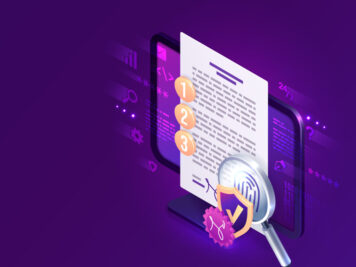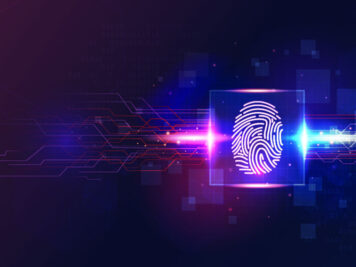Is your password really protecting you? If you’re feeling unsure, you’re not alone. The truth is, it may be weaker than you think. Even with layers of security, seasoned hackers can get through. Once they’re in, your financial and personal information could be exposed. So, how do you strengthen your defenses? Multi-factor authentication (MFA) can be an effective option.
By adding a second step to validate your identity, MFA significantly improves your security measures, protecting your business, online transactions, bank accounts and personal information from potential attacks.
Indeed, the 2024 Data Breach Investigations Report (DBIR) paints a troubling picture, highlighting the need to take charge of your digital security. Here are some takeaways:
- 14% of breaches involved the exploitation of vulnerabilities as initial access, almost triple the number recorded in the previous year’s report.
- 68% of breaches involved a non-malicious human factor, such as someone falling victim to a social engineering attack or making an error.
- 62% of financially motivated events involved ransomware or extortion, resulting in a median loss of $46,000 per breach.
- 15% of breaches involved third-party or vendor, including software supply chains, hosting partner infrastructure, and data custodians.
These alarming statistics show that traditional security methods are simply insufficient.
This guide aims to answer questions like “Why is MFA important to me?” and “How can I implement this effectively in my daily digital practices?” We’ll also discuss the importance of MFA, its benefits, typical types of MFA approaches, and practical procedures for integrating this enhanced security feature into your daily life. By the end of this guide, you will have a deep understanding of where the MFA stands in modern cybersecurity, as well as the tools to improve your digital security.
What is multi-factor authentication?
Multi-factor authentication (MFA), also known as two-step authentication, two-factor authentication, or 2FA, is a security technique that helps protect your online accounts and the sensitive data they hold. When MFA is enabled, you must authenticate your identity with at least two or more forms of authentication before gaining access.
These factors typically fall into three categories:
- Something you know: This could be a PIN or password you created.
- Something you own: This could be a device you own, such as a smartphone, on which you receive a confirmation message or use an authenticator app.
- Something you are: This requires biometric verification, such as a fingerprint, facial recognition, or retina scan.
The combination of these various authentication techniques provides a strong barrier against cyberattacks. Even if an attacker obtains one of your factors, they must still need to compromise the other(s) to gain access to your account. This layered security strategy ensures that only you can access your personal and business information.
How does multi-factor authentication work?
MFA relies on many verification factors, which unauthorized users are unlikely to have. Passwords alone are not enough to securely verify identity. This is why MFA requires several pieces of evidence to confirm a user’s identity.
To understand how MFA works, consider the scenario of withdrawing cash from an ATM. When you want to withdraw money, you will need two things: your debit card and your PIN. These two variables, combined, allow you to enter your account and execute the transaction. The transaction cannot be completed without these two requirements.
Likewise, when using MFA for online accounts, you will be required to give multiple forms of authentication before accessing your account. This can involve entering a password and then receiving a code on your phone, which must also be entered. This can also include biometric verification after entering a password. By requiring multiple forms of authentication, MFA adds an additional layer of security, significantly reducing the risk of unauthorized access.
The most common type of MFA is two-factor authentication (2FA). The principle behind 2FA is that even if malicious actors have one piece of verification, they are unlikely to get the second one. Effective MFA uses authentication elements from at least two different categories. The simple combination of two elements of the same category does not meet MFA safety criteria.
For example, the widely used password and security question combination cannot be considered true MFA since both components fall into the “knowledge” category. On the other hand, a password and a temporary access code meet the criterion since the access code serves as an element of possession, validating ownership of a certain mobile device or email account.
Why is multi-factor authentication important?
According to IBM’s Cost of Data Breach report, phishing and compromised credentials remain among the most common ways attackers gain access to networks. Together, they account for 31% of data breaches. Many of these breaches result from password theft, helping hackers to gain unauthorized access to accounts and devices.
Passwords are particularly sensitive because they can easily be broken by brute force attacks or social engineering schemes. Additionally, many people use the same password for different sites, making it easier for hackers to compromise multiple accounts with a single stolen credential. The consequences can be serious, including identity theft, financial losses and significant disruption for both individuals and businesses.
Implementing multi-factor authentication significantly improves security, reducing the likelihood of account breaches. Research shows that accounts protected by MFA are considered less vulnerable to hacking attempts. This extra protection forces attackers to jump through numerous barriers to access your account. For example, while stealing a password is relatively simple, obtaining other authentication criteria, such as a biometric signature or ownership of a registered device, is significantly more difficult.
Additionally, implementing MFA is not just a security strategy but also a necessity for regulatory compliance. Standards such as the Payment Card Industry Data Security Standard (PCI-DSS) clearly mandate multi-factor authentication for systems that handle sensitive payment information. Other rules, such as the Sarbanes-Oxley Act (SOX) and the General Data Protection Regulation (GDPR), may not expressly require MFA, but installing these systems can help businesses meet the strict safety requirements of these laws. In cases where violations have occurred, regulators have frequently requested the use of MFA as a corrective measure. For example, following a data breach affecting 2.5 million consumers at an online store, the Federal Trade Commission ordered them to apply MFA.
Moreover, adopting MFA improves consumer trust and business reputation. Customers today expect secure systems and are willing to turn to competitors if their trust is violated. Implementing MFA not only protects your accounts, but also shows consumers that you care about their security and privacy.
Types of Multi-Factor Authentication
There are many different types, but here are the most common methods the average user will encounter in their digital life.
1. Time-sensitive one-time codes (TOTC)
Time-sensitive one-time codes are dynamically generated codes that only remain valid for a short period of time, typically 30 to 60 seconds. To use this method, users can download an authenticator app such as Google Authenticator, Microsoft Authenticator, or Authy or use password managers that support TOTC codes.
Once the user enters their password, they must also enter the TOTC to confirm their identity. This method is highly secure because the transient nature of the codes makes them difficult for cybercriminals to intercept, except only if the generating device itself has been compromised.
2. SMS Verification codes
During SMS verification, users receive a unique code sent to their registered mobile number after entering their login credentials. The code must then be entered to complete the authentication process.
Although convenient, this method is less secure due to the ease with which phone numbers can be found or intercepted via SIM swapping techniques, making it vulnerable to cyberattacks. Still, it’s better than not using multi-factor authentication at all.
3. Email verification codes
This method sends a login code to the user’s email address when entering their credentials. The code must then be retrieved from the email and entered for successful login. Although similar to SMS verification, security depends on the robustness of the user’s email account. Using a strong and unique password for the email account is essential to protect this method.
4. Physical security tokens
Physical security tokens, such as USB drives, are tangible devices used to authenticate users. After linking these devices to their account, users must insert the token into a USB port or connect it via near field communication (NFC) to authenticate their identity during the login process.
Solutions like Yubikey or RSA SecurID can be used. This method offers superior security by being immune to Internet theft; however, physical loss or theft of the token remains a concern.
5. Biometric verification
Biometric verification uses unique physical characteristics such as fingerprints, facial recognition, or iris scans to authenticate the user. During initial setup, users register their biometric data, which is then used for further authentication.
This method is highly secure due to the uniqueness of biometric markers. However, unlike passwords, biometric data cannot be changed if compromised, making it crucial to consider them as a secondary rather than primary authentication method.
6. Security questions
Security questions are often used as an additional authentication method, especially over the phone with institutions like banks. Online, these questions provide an extra layer of security.
It is essential to select questions and answers not easily accessible through social media or other public data. Some users choose to provide fake answers for added security. Just make sure you memorize these false answers accurately.
Other type of multi-factor authentication includes
With the integration of machine learning and artificial intelligence (AI), MFA offers even more sophisticated authentication methods.
7. Location-based authentication
Location-based authentication examines the geographic location of a user attempting to access a system, typically using IP address or geolocation data. This method is used to identify and approve or block login attempts based on predefined rules.
For example, access can be restricted to specific regions and denied to others to protect against unauthorized access. Additionally, this can be configured to require an additional layer of authentication if an attempt is made from an unknown or high-risk location, thereby improving overall security by adding a contextual factor into the authentication process.
8. Adaptive authentication
Adaptive authentication, also known as risk-based authentication, dynamically adjusts authentication requirements based on user behavior and the context of the login attempt. This method analyzes factors such as the user’s location, access time, type of device used, and nature of the network connection. By assigning a risk score to each login attempt, adaptive authentication can determine the need for additional verification steps.
For example, a user logging in from a new device at an unusual time may need to provide an additional form of identification, whereas routine access from a familiar device may only require a simple login. a username and password. This approach effectively balances security and user convenience.
Overall, understanding the different types of multi-factor authentication and their benefits can help organizations choose the most appropriate combination to protect their accounts and maintain regulatory compliance.
How to Implement MFA
Implementing MFA can seem daunting at first, but it is a critical step towards securing your online accounts and sensitive information. Here are some tips on how to implement MFA effectively:
Assess Your Needs
Begin by evaluating your organization’s unique requirements. Ask yourself the following questions:
- What kind of data does your organization handle, and how sensitive is it?
- Which accounts or systems contain the most sensitive data and thus require the highest level of security?
- Are there any regulatory requirements specific to your industry that mandate certain levels of security?
- Have there been any past security breaches or vulnerabilities that need to be addressed?
Understanding the nature of your data and the potential risks involved will help you prioritize which areas and accounts require robust MFA solutions.
Choose the right combination of methods
As previously discussed, there are various types of MFA available. Select a combination that best suits your organization’s needs. Consider the following:
- Should different levels of security be applied to different types of accounts?
- Which MFA methods offer the best balance of security and convenience for your users?
- Are there methods that better meet regulatory compliance requirements for your industry?
Having a tailored approach will ensure that MFA implementation is both effective and user-friendly.
Train your employees
Educating your employees about the importance of MFA and how to use it correctly is vital. Here are some steps to consider:
- Conduct comprehensive training sessions to demonstrate how MFA works and why it is essential.
- Provide clear instructions for setting up and using MFA methods.
- Emphasize the risks associated with not using MFA through real-world examples and case studies.
Effective training can significantly reduce human error and increase compliance with security protocols.
Implement strong password policies
While MFA significantly enhances security, it is only effective if accompanied by strong password practices:
- Encourage employees to use complex, unique passwords for different accounts.
- Advise on the use of password managers to generate and store strong passwords securely.
- Enforce regular password changes to minimize the risks of compromised credentials.
Strong passwords are the first line of defense, fortifying the security provided by MFA.
Test it regularly
Periodically testing your MFA system is crucial for maintaining its integrity over time:
- Perform scheduled audits and security assessments to identify any weaknesses or vulnerabilities.
- Simulate breach attempts to see how well your MFA system holds up under attack.
- Promptly address any issues or gaps identified during testing.
Continuous evaluation and improvement of your MFA system help ensure that your accounts remain protected against evolving threats.
By following these tips and implementing MFA, organizations can significantly enhance the security of their digital assets and safeguard sensitive information, all while maintaining regulatory compliance and fostering customer trust. Remember, choosing the right combination of MFA methods and regularly testing your system are key to an effective and robust security strategy.
Challenges and considerations
While MFA offers numerous benefits, there are also some challenges and considerations to keep in mind when implementing it:
- Cost: Depending on the complexity and scope of your organization, implementing MFA may require significant financial investment.
- User experience: Some methods of MFA can be more cumbersome for users, potentially impacting their overall experience.
- Compatibility issues: Not all systems or applications may support MFA, which could limit its implementation in certain areas.
Moreover, organizations must carefully consider how different types of MFA may impact their employees’ productivity and convenience. Implementing a smooth and user-friendly authentication process is crucial to ensure that employees do not resort to workarounds that could compromise security.
It is also essential to regularly review and update your MFA strategy as new technologies and threats emerge. Staying informed about the latest developments in MFA can help organizations adapt their approach accordingly and stay ahead of potential risks.
Future trends in multifactor authentication
The technology industry is leading the way in MFA implementation, with an impressive 87% adoption rate. Larger companies, particularly those with over 10,000 employees, show higher MFA usage at 87%. However, MFA adoption is lower in medium-sized firms (34%) and small businesses (27%). As technology continues to evolve, so do the methods of authentication. Some of the future trends in MFA include:
Advancements in biometric technology
Biometric technology has advanced significantly, offering sophisticated methods like behavioral biometrics. Unlike traditional physical biometrics (fingerprints, iris scans), behavioral biometrics analyzes patterns in human activities. These activities include typing rhythm, mouse movements, and even navigation habits. This adds an additional layer of security because these behaviors are unique to each individual and difficult to replicate.
This focus on behavior strengthens Multi-Factor Authentication (MFA). In fact, over two-thirds of organizations (66%) now require some form of biometrics for authentication. This significantly increases the difficulty for hackers. Replicating biometrics or obtaining a stolen one-time code is much more challenging than simply guessing or stealing a password.
Furthermore, continuous advancements in biometric sensors and algorithms have led to enhanced accuracy and security. Modern systems minimize false positives and negatives, offering a more reliable way to verify user identities. This is especially crucial for sectors handling highly sensitive information, such as finance and healthcare.
AI and Machine Learning
AI and machine learning are also playing a significant role in the future of MFA. These technologies can detect anomalies in user behavior, such as logging in from an unfamiliar location or at an unusual time, triggering additional authentication steps. This adds another layer of security without adding burden to the user experience.
AI can also analyze data patterns and identify potential security threats before they occur. It can adapt and learn from past incidents, making it increasingly effective at preventing cyberattacks. However, it is important to note that AI is not infallible and must be constantly monitored and updated to stay ahead of evolving threats.
Decentralized Authentication
Decentralized authentication is another emerging trend in MFA. This method distributes the authentication process across multiple devices rather than relying on a centralized server. This reduces the risk of a single point of failure and minimizes the potential impact of a data breach.
Decentralized authentication also offers increased privacy as user credentials are not stored in one central location. Instead, they are distributed across different devices, making it more difficult for hackers to access sensitive information. This can be especially beneficial for organizations handling large amounts of personal data.
Conclusion
As technology continues to evolve, the need for strong and reliable authentication methods becomes increasingly crucial. MFA offers an effective and robust solution to protect digital assets, sensitive information, and maintain regulatory compliance. By understanding the challenges and considerations associated with implementing MFA and staying informed about future trends in this area, organizations can ensure they are adequately protecting their systems and maintaining customer trust.
Remember, it is never too late to implement or improve your MFA strategy – prioritize security today to prevent potential breaches tomorrow. So, keep these tips in mind as you continue to stay ahead of the curve with multifactor authentication. Happy authenticating!


